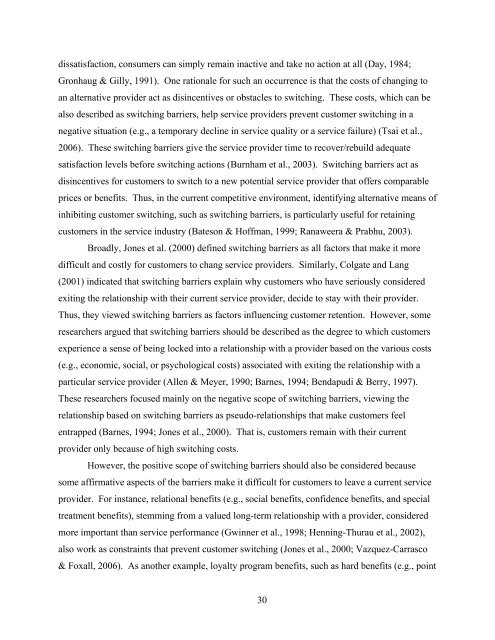View - K-REx - Kansas State University
View - K-REx - Kansas State University
View - K-REx - Kansas State University
Create successful ePaper yourself
Turn your PDF publications into a flip-book with our unique Google optimized e-Paper software.
dissatisfaction, consumers can simply remain inactive and take no action at all (Day, 1984;<br />
Gronhaug & Gilly, 1991). One rationale for such an occurrence is that the costs of changing to<br />
an alternative provider act as disincentives or obstacles to switching. These costs, which can be<br />
also described as switching barriers, help service providers prevent customer switching in a<br />
negative situation (e.g., a temporary decline in service quality or a service failure) (Tsai et al.,<br />
2006). These switching barriers give the service provider time to recover/rebuild adequate<br />
satisfaction levels before switching actions (Burnham et al., 2003). Switching barriers act as<br />
disincentives for customers to switch to a new potential service provider that offers comparable<br />
prices or benefits. Thus, in the current competitive environment, identifying alternative means of<br />
inhibiting customer switching, such as switching barriers, is particularly useful for retaining<br />
customers in the service industry (Bateson & Hoffman, 1999; Ranaweera & Prabhu, 2003).<br />
Broadly, Jones et al. (2000) defined switching barriers as all factors that make it more<br />
difficult and costly for customers to chang service providers. Similarly, Colgate and Lang<br />
(2001) indicated that switching barriers explain why customers who have seriously considered<br />
exiting the relationship with their current service provider, decide to stay with their provider.<br />
Thus, they viewed switching barriers as factors influencing customer retention. However, some<br />
researchers argued that switching barriers should be described as the degree to which customers<br />
experience a sense of being locked into a relationship with a provider based on the various costs<br />
(e.g., economic, social, or psychological costs) associated with exiting the relationship with a<br />
particular service provider (Allen & Meyer, 1990; Barnes, 1994; Bendapudi & Berry, 1997).<br />
These researchers focused mainly on the negative scope of switching barriers, viewing the<br />
relationship based on switching barriers as pseudo-relationships that make customers feel<br />
entrapped (Barnes, 1994; Jones et al., 2000). That is, customers remain with their current<br />
provider only because of high switching costs.<br />
However, the positive scope of switching barriers should also be considered because<br />
some affirmative aspects of the barriers make it difficult for customers to leave a current service<br />
provider. For instance, relational benefits (e.g., social benefits, confidence benefits, and special<br />
treatment benefits), stemming from a valued long-term relationship with a provider, considered<br />
more important than service performance (Gwinner et al., 1998; Henning-Thurau et al., 2002),<br />
also work as constraints that prevent customer switching (Jones et al., 2000; Vazquez-Carrasco<br />
& Foxall, 2006). As another example, loyalty program benefits, such as hard benefits (e.g., point<br />
30
















